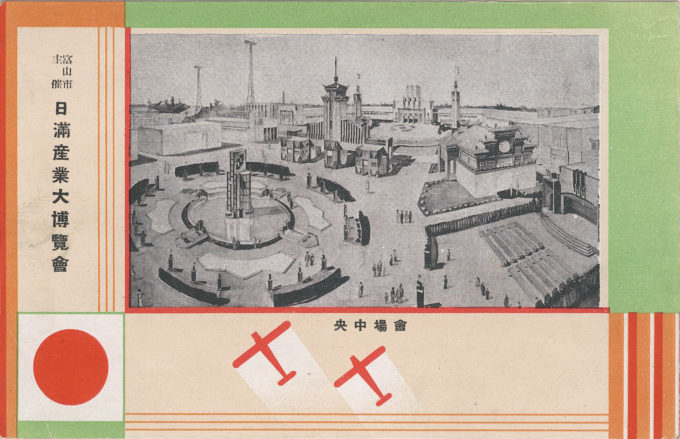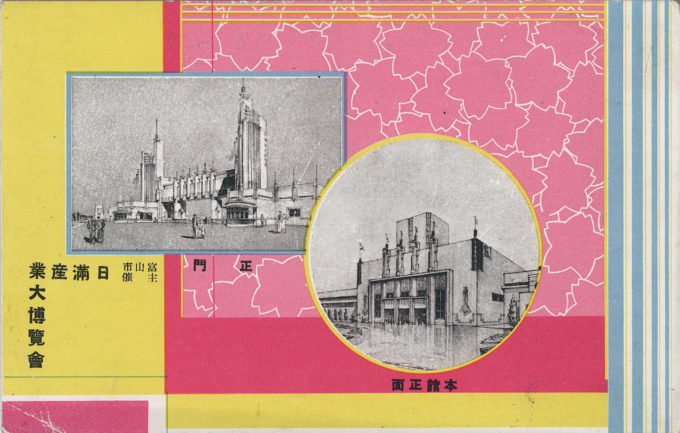
Central Plaza, Japan-Manchuria Great Industrial Exposition, Toyama Prefecture, 1936. Held between mid-April and early June 1936 and hosted by Toyama Prefecture, the Japan-Manchuria Industrial Exposition was designed to promote trade and industry with Japan’s new colonial state, Manchukuo (Manchuria).
See also:
Hiroshima Showa Industrial Exposition, 1929.
Japanese Pavilion, A Century of Progress International Exposition, Chicago, 1933.
Exposition celebrating the 70th anniversary of the “Meiji Assembly”, Ueno Park, Tokyo, 1938.
Exposition of Shining Technology (2,600th National Foundation Anniversary), 1940.
“Toyama’s visions of greatness through empire began in the 1890s, with the build-up to the Sino-Japanese War, as well as the predicted opening of the Trans-Siberian Railroad. However, despite the efforts of people like Fujii Nozo, whose 1891 Fushiki Chikko-ron argued that Fushiki was perfectly placed to trade with Eaurope via Vladisvostok and the Trans-Siberian, at this early stage it was largely theprovince of over-enthusiastic journalists trumpeting local patriotism.
“However, the tone is modified after the Unification with Korea, to accommodate a more commercial viewpoint. As the Prefectural Governor, Hamada Tsunenosuke, noted in 1913, the Japan Sea was now ripe for making into Japan’s ‘Garden’.
“After the formation of Manchuria [in 1931], interest in the possibilities of trans-Japan Sea trade peaked once again, with the sending of delegations of business and political leaders across on fact-finding missions. This interest reached its zenith with the 1936 Japan-Manchuria Great Industrial Exposition, dedicated to the concepts of trans-maritime trade and prosperity, and the benefits to the local region through such.
“… Held for fifty-five days, from the 15th of April to the 8th of June 1936, the expo was designed to show off the modern city of Toyama to potential investors. In that respect it was similar to Kanazawa’s expo [of 1933], held as it was after the completion of major infrastructure (although in Toyama’s case this included the modern port of Higashi-Iwase and the Toyama Airfield).
“The expo site itself was also intended as a showcase of modern town planning. Sited on land reclaimed from the Jinzu River, it was designed to become part of the modern cityscape after the expo closed. The site itself was part of the city’s desire to present itself as the central city of the Japan Sea coast.
“… While Kanazawa’s interest in Manchuria, stimulated by its expo and by the events of the time, was short-lived, Toyama’s was deeper-rooted and ultimately far more successful through the development of its ports and the relocation of such giant factories as Nichi-Man Aluminum, the largest in the country, to take advantage of the region’s cheap electricity the imports of bauxite from Manchuria.
“Toyama’s expo showed a city much more confident in its future. Rather than a desperate effort to attract industry to slow the gradual decline of a once-powerful city [i.e. Kanazawa], Toyama’s expo was designed as a way to focus national attention not on the city’s need for industry but rather on its potential to promote trade and imperialistic ideals.
“It was a celebration of peacetime imperialism at its height.”
– The “Japan Sea Era”: Imperialism and Regional Identity in the 1930s, by Jeremy D. Phillips, 2008


